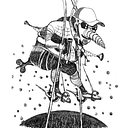by Vas Mylko
Our mission — Curiosio — the smartest travel search tech with the most intriguing look & feel. The previous post — Evolutionary AI — was about the cutting edge artificial smartness. This post is about the most beautiful look for the tech.
We invented and conceptualized Una Curiosità back in early 2018. Check out what and how we were thinking about it in the post When It Works, How Will It Look. We elaborated details and requirements in the late 2018. Check out the interesting process [with Elon Musk involved ] in the post Una Curiosità.
Today we are sharing the work in process. The artists are smart and talented. They study the known and unknown history of the places. Visualization goes with embedding the facts and preserving the accuracy. The signatures and attributions of the artists will be linked when the art works are ready.
Yonge Street
Yonge Street is a major arterial route in the Canadian province of Ontario connecting the shores of Lake Ontario in Toronto to Lake Simcoe, a gateway to the Upper Great Lakes. Until 1999, the Guinness Book of World Records repeated the popular misconception it was 1,896 km (1,178 mi) long, and thus the longest street in the world. The construction of Yonge Street is designated an Event of National Historic Significance in Canada. Yonge Street has been referred to as “Main Street Ontario”.
Maunsell Forts
The Maunsell Forts are armed towers built in the Thames and Mersey estuaries during the Second World War to help defend the United Kingdom. They were operated as army and navy forts, and named after their designer, Guy Maunsell. The forts were decommissioned in the late 1950s and later used for other activities including pirate radio broadcasting. One of the forts is managed by the unrecognised Principality of Sealand; boats visit the remaining forts occasionally, and a consortium called Project Redsands is planning to conserve the fort situated at Red Sands.
Oak Island Mystery
The Oak Island mystery refers to stories of buried treasure and unexplained objects found on or near Oak Island in Nova Scotia. Since the 19th century, a number of attempts have been made to locate treasure and artifacts. Theories about artifacts present on the island range from pirate treasure, to Shakespearean manuscripts, to possibly the Holy Grail or the Ark of the Covenant, with the Grail and the Ark having been buried there by the Knights Templar.
Various items have surfaced over the years that were found on the island, some of which have since been carbon-dated and found to be hundreds of years old. Although these items can be considered treasure in their own right, no significant main treasure site has ever been found. The site consists of digs by numerous people and groups of people. The original shaft, in an unknown location today, was dug by early explorers and known as “the money pit”. “The curse” is said to have originated more than a century ago and states that seven men will die in the search for the treasure before it is found. To date, six men have died in their efforts to find the treasure.
Mount Rushmore
Mount Rushmore National Memorial is centered on a sculpture carved into the granite face of Mount Rushmore in the Black Hills in Keystone, South Dakota, United States. Sculptor Gutzon Borglum created the sculpture’s design and oversaw the project’s execution from 1927 to 1941 with the help of his son Lincoln Borglum. The sculpture features the 60-foot (18 m) heads of Presidents George Washington (1732–1799), Thomas Jefferson (1743–1826), Theodore Roosevelt (1858–1919), and Abraham Lincoln (1809–1865), as recommended by Borglum. The four presidents were chosen to represent the nation’s birth, growth, development, and preservation, respectively.
Mount Rushmore has a secret chamber. A little-known chamber concealed behind the head of Abraham Lincoln was intended to contain a shrine to America. Right where the frontal lobe of Abraham Lincoln’s brain would be, there is instead a secret room that contains the text of America’s most important documents. Hall of Records is a legitimate historical repository. Sealed behind a 1,200-pound granite slab and tucked inside a wooden box are the US Constitution, the Declaration of Independence, the Bill of Rights, and short descriptions of each president featured on the monument. The text of each document is carved into a series of porcelain enamel panels.
Casa Batlló
Casa Batlló is a building in the center of Barcelona. It was designed by Antoni Gaudí, and is considered one of his masterpieces. A remodel of a previously built house, it was redesigned in 1904 by Gaudí and has been refurbished several times after that. Like everything Gaudí designed, Casa Batlló is only identifiable as Modernisme or Art Nouveau in the broadest sense.
The ground floor, in particular, has unusual tracery, irregular oval windows and flowing sculpted stone work. There are few straight lines, and much of the façade is decorated with a colorful mosaic made of broken ceramic tiles (trencadís). The roof is arched and was likened to the back of a dragon or dinosaur. A common theory about the building is that the rounded feature to the left of centre, terminating at the top in a turret and cross, represents the lance of Saint George (patron saint of Catalonia, Gaudí’s home), which has been plunged into the back of the dragon.
More…
More to come. There are tens of mega interesting places. They are jaw dropping. There are hundreds of very interesting places that are mind bending. We will visualize them all in the artistic manner to communicate the essence directly via emotional link. These objects and places will be linked to Curiosio UX. Stay tuned for the news and follow your curiosity.
